Hatchling Leopard Gecko Care
This page provides information regarding the care of hatchling leopard geckos. The information is the result of knowledge I have gained through experience of caring for hatchling leopard geckos, plus reading other care sheets, books and discussions on various web forums. This information represents what I have personally found useful and interesting. For further information on leopard gecko care, please refer to the basic leopard gecko caresheet or comprehensive leopard gecko caresheet.
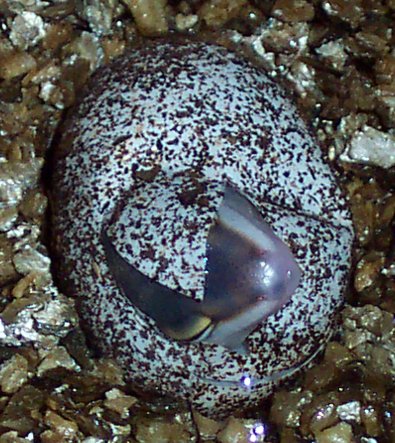 |
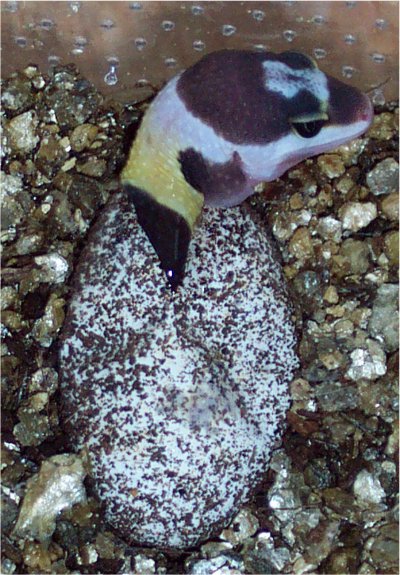 |
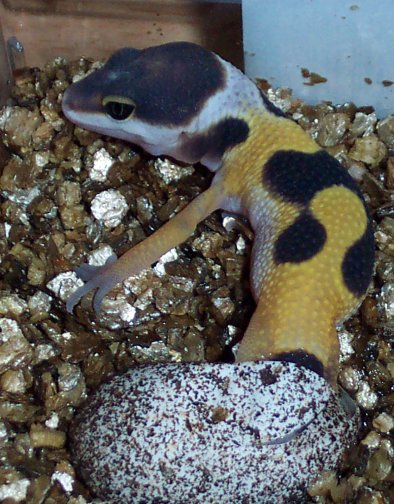 |
So, congratulations!!!!! Your baby leopard gecko has hatched. How do you care for it? The quick answer is: much the same as the adults, but there are a few differences.
Hatchling behaviour
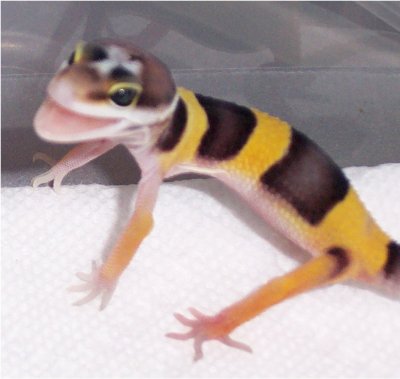 The
first thing to remember is that this new baby has never seen you before,
doesn't know what you are and will likely be petrified of you- their first
reaction will be fear- to them you are most likely a predator. Most (but
not all) newly hatched leopard geckos will hiss, screech (like the high pitched
noise you hear when you let air escape from a balloon very slowly), lunge
and try to bite. They will, of course, not hurt you should they contact you...
but it is good to know to expect them to behave in this manner, so you can
be as calm as possible when dealing with them- if you're not expecting it,
they WILL make you jump.
The
first thing to remember is that this new baby has never seen you before,
doesn't know what you are and will likely be petrified of you- their first
reaction will be fear- to them you are most likely a predator. Most (but
not all) newly hatched leopard geckos will hiss, screech (like the high pitched
noise you hear when you let air escape from a balloon very slowly), lunge
and try to bite. They will, of course, not hurt you should they contact you...
but it is good to know to expect them to behave in this manner, so you can
be as calm as possible when dealing with them- if you're not expecting it,
they WILL make you jump.
I like to leave any newly hatched babies in the incubator for a few hours (normally about 12) so they can recover after the ordeal of hatching (if any of the yolk sac is still to be absorbed, see potential hatchling problems below, I leave them in the incubator longer). Hatching takes a large amount of effort, so it is best for the hatchling to recover in peace. Having said that, some of the hatchlings do have a tendency to dig all around their incubation box, possibly in an attempt to get out. This is not a problem if the hatchling is all that is in the box, however, if you have other eggs incubating, they can dig them up, roll them over, etc! So, you may prefer to move them from the incubator sooner.
Hatchling set-up
Before your babies start hatching, you should ensure that you have a set up ready to transfer them to. On hatching, the babies are very small (2.5-3 inches snout to tail tip) and normally weigh anywhere from 3-5g. Hatchlings do best in smaller set ups such as that shown below.
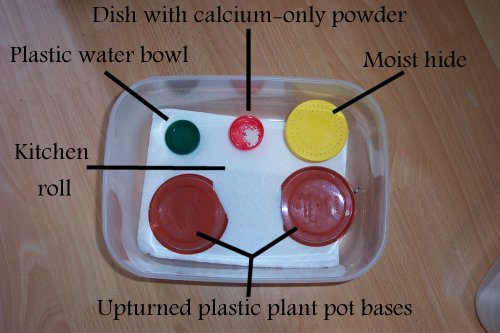
The above photo shows an example set up for hatchling leos. Hatchlings are best kept separately, this prevents competition for food, bullying and allows you to monitor each one individually. Therefore, I would advise to keep one leo per container. The following gives more detail of the above container.
- Container dimensions: 10 inches long x 8 inches wide and x 6 inches high.
- Heat: The best source of heat for leopard geckos is a heat mat, the heat mat should be placed underneath (i.e. outside the container) at one end (to create a warm end), covering about one third of the container's base. The heat mat should be connected to a thermostat to regulate the temperature (temperature on the substrate at the warm end should be 88F).
- Substrate: The only substrate to be used with juveniles is kitchen roll. Babies are very small, therefore, their digestive tracts are also very small and are even more vulnerable to substrate impaction. Kitchen roll is also ideal because once the babies start eating, they will require frequent cleaning out, the kitchen roll is very easy to replace to ensure the enclosure is kept very clean.
- Hides: Hides are important so that the baby can feel secure, I like to provide 1 normal hide and a moist hide at the warm end and 1 hide at the cool end. The normal hides can be made from coconut shells, or from upturned plant saucers with entrance holes cut in them, and the moist hide can be made from either a small tuperware tub, or a waxworm tub (see instructions on how to make a moist hide below). It is good to have one heavier hide or dish in the container for them to rub against when shedding their skin.
- Water bowl: can be either purpose bought bowl, or a plastic milk bottle top or similar. The water bowl should always be shallow to prevent the baby from drowning and it also prevents the crickets from drowning!
Making a moist hide
Moist hides for baby leopard geckos can be made easily, quickly and cheaply from waxworm tubs. Take the tub and cut a semicircle from the plastic on the top of the tub part (ensure there are no sharp edges by running your finger around the cut egde). Place some damp kitchen roll inside the tub and place the lid on- easy as that!
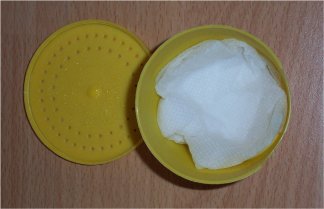 |
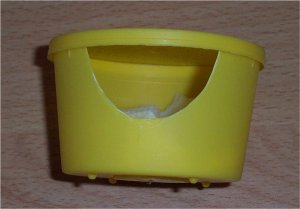 |
Transferring the baby to its new home
To avoid stressing the baby out too much when transferring it to its new home, it is best not to handle them at all. The easiest thing to do is to take the container that the baby has hatched in and move it into the baby's new home. Remove the lid from the incubtion container, then "steer" the baby to encourage it to move out of the incubation container and into its new home. Then replace the lid on the babys new home and put the container onto the heatmat. Once the baby is in its new set up, you should leave it to settle in, do not disturb it unnecessarily.
Hatchling care
Once in its new home, the baby should not require much attention for the first few days. Obviously, you should monitor it to make sure it is ok, however, you should not have to do much else. On a daily basis you should check that it has water available and that it's moist hide is moist.
Just before hatching, the geckos absorb the remains of the yolk sac, it is for this reason that they do not need to eat for the first few days. Normally, the first thing they eat is their shed skin- which they shed sometime in the first 2-4 days after hatching. The shedding process is normally quite quick and you may not even be aware that the gecko has shed. Often the first clue that shedding has taken place is a greenish/white/grey coloured poop!, the remains of the skin give it this unusual colour.
The hatchlings will normally start eating after their first shed. It is important to offer them appropriately sized food, i.e. it should be no wider than the width of their head. Crickets are the best food for babies (waxworms are too fatty, mealworms are not recommended as they are quite large and difficult to digest), although silkworms are also suitable. For a first meal, your hatchling leopard gecko may eat just 1 cricket, the number of crickets eaten per feeding will increase very quickly over the first few days and soon they will eat up to 10 (maybe more) food items per day. Gutloading and dusting of the livefood is obviously just as important as it is for the adults. For hatchlings, all livefood should be well gutloaded and it should also be dusted with calcium-only powder 5 times per week, the other two feeds in that week should be dusted with a powder containing calcium and vitamins (e.g. nutrobal).
Hatchling problems
This section is to be added..... Check back soon, if you would like to inform us of any problems that you have noted in your hatchlings, please contact us. Many breeders may not like to admit to having hatched leos with problems, however it does happen and I would like to make this a useful resource for gecko breeders where people can share and learn about the possible problems that can occur in hatchlings.
